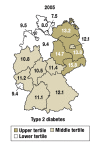Overweight, obesity and high waist circumference: regional differences in prevalence in primary medical care
- PMID: 19578419
- PMCID: PMC2697019
- DOI: 10.3238/arztebl.2008.0827
Overweight, obesity and high waist circumference: regional differences in prevalence in primary medical care
Abstract
Introduction: The prevalence of obesity and elevated waist circumference in Germany is high. However, there are insufficient data on the situation in primary care and on regional distribution to support medical preventive measures.
Methods: The German Metabolic and Cardiovascular Risk Project (GEMCAS) is a national cross-sectional study including 1511 primary care practices and 35 869 patients. Height, weight, waist circumference, laboratory values, and type 2 diabetes were documented.
Results: The crude prevalence of obesity was 23.9% (95% CI 23.4 to 24.3) (standardized 22.8% [95% CI 22.3 to 23.2]), with a minimum in Bremen (19.8% [95% CI 15.1 to 24.5]) and a maximum in Saxony-Anhalt (28.3% [95% CI 25.4 to 31.1]). The crude prevalence of high waist circumference (> 102/88 cm) was 39.5% (95% CI 39.0 to 40.0) (standardized 36.5% [95% CI 36.0 to 36.9]), with a minimum in Hamburg (30.5% [95% CI 26.2 to 34.8]) and a maximum in Saxony-Anhalt (42.1% [95% CI 39.2 to 45.1]). The prevalence of obesity as assessed by BMI was higher in men than in women, but greater in women as assessed by waist circumference. Nationwide, 50 out of every 100 patients with obesity had type 2 diabetes, and 32 of 100 patients with a high waist circumference had type 2 diabetes.
Conclusions: The prevalence of obesity is higher in northeastern Germany than in the southwest. Overall, abdominal obesity is considerably more frequent than obesity based on BMI. Surprisingly, a high prevalence of obesity in some federal states does not automatically mean a higher number of people with type 2 diabetes.
Keywords: body mass index; obesity; overweight; prevalence; regionalization; type 2 diabetes.
Figures



References
-
- Helmert U, Strube H. Die Entwicklung der Adipositas in Deutschland im Zeitraum von 1985 bis 2002. Gesundheitswesen. 2004;66:409–415. - PubMed
-
- Max Rubner Institut. Nationale Verzehrs-Studie II. www.was-esse-ich.de/uploads/media/NVS_II_Ergebnisbericht_Teil_1.pdf.
-
- Prugger C, Keil U. Entwicklung der Adipositas in Deutschland - Größenordnung, Determinanten und Perspektiven. Dtsch Med Wochenschr. 2007;132:892–897. - PubMed
-
- Flegal KM, Carroll MD, Ogden CL, Johnson CL. Prevalence and trends in obesity among US adults, 1999-2000. JAMA. 2002;288:1723–1727. - PubMed
-
- World Health Organization. Obesity - preventing and managing the global epidemic. Geneva: WHO Technical Report; 2000. Series 894. - PubMed
LinkOut - more resources
Full Text Sources

